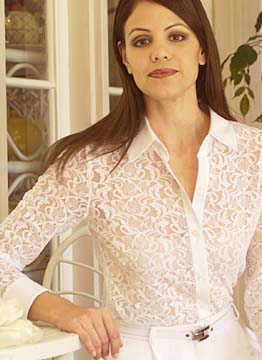



|
It was proclaimed after Sept. 11 that fashion was dead. Few believed the frivolity and excess of America circa 2000 would survive in light of the ferocity of the terrorist attacks on the East Coast. Given the weightier issue of an impending war against the Taliban and the stock market's plummet, New York and European designers canceled their spring shows. The era of minimalism surrenders
to loose skirts, diaphanous tops
and funky accessoriesBy Nadine Kam
nkam@starbulltin.comEven in sunny Hawaii, unusually chilly fall winds slammed us from the Northwest. Light rain on the Big Island even gave way to a hail storm, as if to punctuate our gray mood. We couldn't wait for the soggy weather and clouds to dissipate, and to be rid of those sweaters, that, no matter how refined, have wearers feeling like bloated, shaggy dogs.
The straitjackets are off. Spring has emerged with a palette of hope. Stroll through the malls and you will see color, texture, weightless fabrics, funky accessories, floral prints and motifs, and a renewed sense of play, awakened after a decade of dormancy.
Retailers were surprised by the early reception to spring lines. "We thought people would only want basic fashion that didn't say anything, and actually we've seen the opposite," Ken Downing, fashion spokesman for Neiman Marcus told the Boston Globe. "They want signature runway pieces that say something, because they want something that will bring some joy to them when they put them on."
It's as if we forgot fashion's power, which like music and literature, is an expression of the human spirit, and here, the American way. One need only read interviews with Afghanistan women forced to wear the black-hooded floor-length burqa to understand how lucky we are to have the ability to assert our individuality through the clothes we wear, among other means.

|
That's why, after expressing initial Sept. 11 grief, designers bounced back to finish the work they started nearly two years ago, as if to counter any ugliness with beauty. The move buries the minimalist era of simple slip dresses, camisole tops and pencil skirts, in favor of something more organic than architectural.What started as small flirty ruffles at hemlines and cuffs has billowed into full-fledged flamenco looks with cascades of ruffles spilling down the center of wrap skirts, and sending collars and cuffs aflutter.
This is the dawning of the age of romance, and the rebirth starts with the purity of white, which appears in ladylike button-down blouses, romantic prarie-style or high-collared Victorian tops or gauzy peasant blouses embellished with light beading or Mexican embroidery. Pretty, yes, but so difficult to wear. Be sure to stock up on bleach and Woolite, or get to know a dry cleaner.
These tops are matched by soft bias-cut skirts that flow, or sturdy, three-tiered voluminous skirts, the start of a trend toward looser, less body-conscious clothing.
As if to ward off the evils of a world gone high-tech and impersonal, designers also went in search of the talismans that allow them to reconnect with their primitive souls. They found it in turquoise, coral and other semi-precious stones used in chunky jewelry or to embellish handbags, belts, ethnic garments and sandals. Earth-colored suede also turns up in hippie-style handbags, macrame belts and embroidered tunic tops.

|
Noting a mass reluctance to jet off to Peru or Mexico or Tibet and other points, designers allow us to sit back while they bring the world to us in fabrics, silhouettes and accessories inspired by other cultures.NOW, HERE IS the dilemma. With garments recasting the strong, capable, independent woman of the '90s as bohemian wild child, Victorian damsel or Third World peasant, how will we adjust to a world of creativity run amok?
Nearly a decade of minimalism has been wonderful for both fashion victim and fashion-challenged. The simplicity of neat, chic, spare dressing left little room for the horrors and excesses of the so-called Big '80s, with its big hair, big shoulders, theatrical makeup, poufed skirts and leg warmers, to name a few. Alexis Carrington, anyone?
In the '90s, we cleaned up our acts, turning out so polished we probably started believing in our innate fashion sense.
Don't be fooled. This season it will be a challenge to avoid looking like Pagliacci in layers of ruffles. And before you reach for a puffy-sleeved princess blouse, think about Jerry Seinfeld's "puffy shirt" episode. As one guy said to me while passing a Japanese tourist in a gauzy princess blouse: "Now that's a mistake." (I thought she looked really cute.)
Those who don't speak the language of fashion will not immediately grasp the revolution taking place before their eyes. In photographing some of the pieces for this issue, office males looking at the lacy sheer tops inquired breathlessly, "Is that lingerie?"

|
It seems that it is all too easy to mistake a romantic for a boudoir look, and while women can hrrmph and moan about the one-track male mind, it is important to note that our comfortable white cotton camisole will always be some guy's idea of jammies, so throw a corduroy jacket over it if necessary.Another helpful tip: If you remember wearing any of this stuff 30 years ago there's a pretty good chance you'll look silly repeating yourself. My favorite outfit around age 10 was a white peasant top with a short puffed sleeve, tucked into a full red skirt and accessorized with a lace-up mini-corset peasant belt. Put a water jug on my hips and call me Sophia, I'm not doing that again.
If all this seems confusing, just take a deep breath and take it slow. Over at Macy's, director of special events Lavina Wong considers herself an old-fashioned kind of gal and says trends can easily be adapted to one's lifestyle. The lady who lunches can easily pull off layers of soft ruffles, while those who prefer to play the tough girl can pair a simple ruffled or ruched T-shirt with patched or painted jeans. "It's possible to be fashionable but not blatant," Wong said. "I still like it clean and modern."